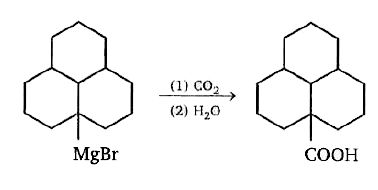Compare the two methods shown for the preparation of carboxylic acids:

Mehod 1 : RBrMg−−−−−−→diethyl etherRMgBr1.CO2−−−−→2.H3O+RCO2H
Method 2 : RBrNaCN−−−→RCNH2O,HCl−−−−−→heatRCO2H
Which one of the following statements correctly describes this conversion ?
 Solution in Kannada
Solution in Kannada
Both method 1 and method 2 are appropriate for carrying out this conversion
Neither method 1 nor method 2 is appropriate for carrying out this conversion
Method 1 will workwell, but method 2 is not appropriate
Method 2 will workwell, but method 1 is not appropriate
The correct Answer is:C
At bridge head SN2 doesn.t take place. According to bredt.s rule bridge head carbon can.t be sp2-hybridized.
(Nal + Acetone) + R -X reaction SN2 depends on
(1) Leaving group tendency  is suitable preparation.
is suitable preparation.
(2) Steric crowding .
Topper's Solved these Questions
- 5C ALKYL HALIDES BOOK - MS CHOUHANCHAPTER - 5C ALKYL HALIDES EXERCISE - LEVEL-2
3 Videos
- 5C ALKYL HALIDES BOOK - MS CHOUHANCHAPTER - 5C ALKYL HALIDES EXERCISE - LEVEL-2 (SUBJECTIVE PROBLEMS)
1 Videos
- ALCOHOL,ETHERS AND EPOXIDESBOOK - MS CHOUHANCHAPTER - ALCOHOL,ETHERS AND EPOXIDESEXERCISE - SUBJECTIVE PROBLEMS
1 Videos
Similar Questions
The following organic halide derivatives (A to J) are reacted in ethanol solution with each of the nucleophiles : acetate, methylthiolate, cyanide and hydroxide anions. Six possible results from these combinations of reactants are designated (1) through (6) below:
Write the number corresponding to your best estimate of the outcome ofeach reaction in the appropriate answer box below.

View Solution
X = Total number of substitution and elimination product(s). Find the value of X.
View Solution
Maximum number of moles of Ac2O consumed by reactant (A) is :
View Solutionoverset (NaBH_4) (rarr) overset ((i) H_2O^+)underset (Delta) (rarr) A, A is .
View Solutionunderset(("Monosubsitituted benzene"))(P)overset(Na(Hg))underset(+conc. H_(2)SO_(4))rarr Q overset(NaNO_(2))underset(+HCl.0^(@).5^(@)C)rarr R overset(KCN)underset(CuCN)rarr S overset(SnCl_(2))underset(HCl)rarr T Correct statement are :
View SolutionC_(6)H_(5)CH_(2)underset(Br)underset(|)CHCH_(3)underset("heat")overset(aic. KOH)rarr ? overset(HBr)rarr ?
View SolutionCH3MgBrCO2−−→(A)H2O−−→H+(B)
View SolutionWhat is the major product (Z) of the reaction? PhCOOH underset(H_2SO_4)overset(HNO_3)(rarr) overset(Sn//HCl)(rarr)underset(HCl)overset(NaNO_2)(rarr)underset(Delta)overset(H_2O)(rarr)
View SolutionIn the given reaction sequence CH_3CHO underset((ii)H_2O^+)overset((i) NaCN//HCl)(rarr)(A) underset("reagent")overset("Fenton")(rarr)(B) , B will be
View SolutionWhat are Xand Y =in the following reaction sequence? " Propene " overset(HBr)rarr A overset(Mg)underset("Dry ether")rarr B overset(1.x)underset(2. H_3O^+)rarr
View Solution(CH3)2CONaCN−−−→(HCl)AH3O+−−−→ΔB.
In the above sequence A and B are
View SolutionCH3−BrMg−−−−−→etherX(CH3)3C−OH−−−−−−−−−→A. Product A is
View SolutionCH,COOH -overset(Cl_2.P)(rarr)A underset(C_2H_5OH//H^+)overset("esterification")(rarr)B overset(alc. KCN)(rarr)C underset(H_2O//H^(+))overset(hydrolysis)(rarr)D underset(-CO_2)overset("heat" 150^@C)(rarr)E .Name the functional isomer of compound E in the above sequence.
View SolutionIdentify the structure of the compounds A, B and C in the following reactions. CH_3Br overset(Mg//ether)rarr A overset ((i) CO_2)underset ((ii) Water)rarr B overset (CH_3OH//H^(o^+))underset(delta)rarr C
View SolutionIdentify A, B, C, D.
CH3INa−−→EtherACl2−−→hvBAq.NaOH−−−−−→C170∘C−−−−−−−→Conc.H2SO4D
View SolutionIdentify A→D CH3Br+MgDry−−→etherAdry−−→iceBH2O−−→CAgOH−−−→CH3COOAg+Br2Cl4−−→D
View Solution
